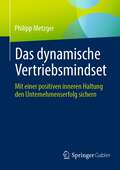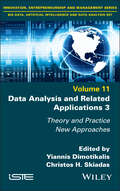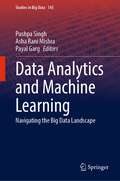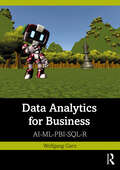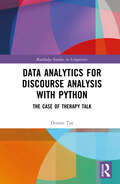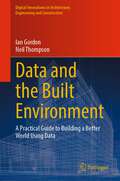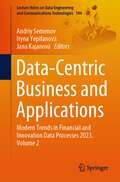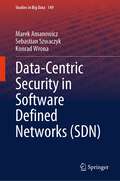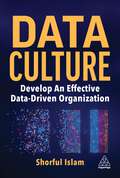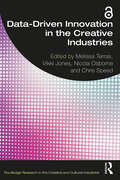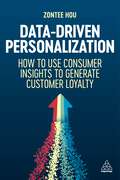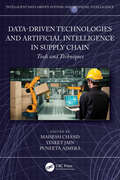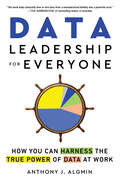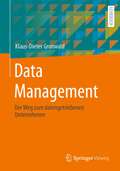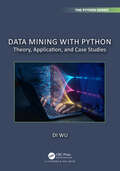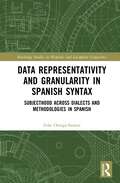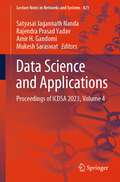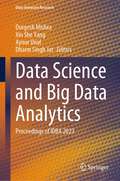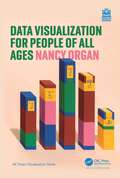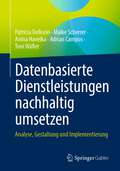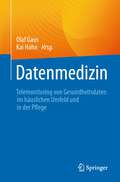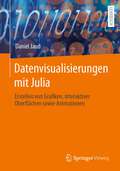- Table View
- List View
Das dynamische Vertriebsmindset: Mit einer positiven inneren Haltung den Unternehmenserfolg sichern
by Philipp MetzgerDieses Buch erläutert, warum die innere Haltung von Mitarbeitenden ein entscheidender Erfolgsfaktor ist und wie Vertriebsorganisationen diese gezielt fördern können. Konkret geht es um das dynamische Mindset, welches wesentlich zum Erfolg beiträgt, vor allem in Change-Phasen, die etwa im Rahmen von Digitalisierungsbestrebungen in Unternehmen stattfinden. Individuelle Emotionen und Motivationen, Prozesse und Kennzahlen müssen dann zusammengeführt werden.Der Autor zeigt die psychologischen Hintergründe zur Macht von Gedanken auf, und erklärt, wie ein dynamisches Mindset bei Menschen entsteht, welche unterschiedlichen Ausprägungen es gibt und welche Möglichkeiten zu einer positiven Veränderung bestehen. Er erläutert, wie ein Mindset zu jedem Zeitpunkt im Leben durch aktives Steuern beeinflusst werden kann und wie Vertriebsmitarbeiter und Führungskräfte hierbei gezielt vorgehen können – um Strahlkraft ins gesamte Unternehmen zu gewinnen und dieses nachhaltig erfolgreicher zu machen.
Das Recht der Fiktion: Zu den Lizenzen und juristischen Implikationen fiktionalen Schreibens (Theorema. Literaturtheorie, Methodologie, Ästhetik #3)
by Nursan CelikVerrechtlichungsprozesse von Literatur stellen als Kollisionsfall von Kunstfreiheit und allgemeinem Persönlichkeitsrecht nicht nur für die Jurisprudenz eine Herausforderung dar. Auch die Fiktionstheorie findet im besonderen Redestatus und den Fiktionslizenzen der Literatur ein reiches Feld. Die vorliegende Studie widmet sich systematisch anhand tatsächlich verhandelter Fälle und mit Blick auf neuere Fiktionsansätze der Frage, ob fiktionalen Texten Persönlichkeitsrechtsverletzungen angelastet werden können. Hierfür wird ausgehend von der Referenzstruktur fiktionaler Literatur untersucht, in welchen Fällen sich Elemente in der Darstellung literarischer Figuren auf reale Personen beziehen lassen und infolgedessen justiziabel werden können.
Das Retinale Pigmentepithel – Physiologie und Pathologie
by Alexa Karina Klettner Stefan DithmarDieses Buch bietet eine aktuelle Quelle zu einem der Hauptakteure bei Netzhauterkrankungen - dem Retinalen Pigmentepithel (RPE). Im gesamten Buch werden die physiologische und die pathologische Funktion des RPE gleichberechtigt behandelt, um dem Leser zu helfen, das RPE als Ganzes zu verstehen. Darüber hinaus werden die Entwicklung des RPE in Diagnostik und Therapie sowie einige praktische Erkenntnisse über experimentelle RPE-Modelle behandelt. Retinal Pigment Epithelium in Health and Disease hebt neue Erkenntnisse der RPE-Forschung hervor und enthält den aktuellen Wissensstand zu jedem vorgestellten RPE-Thema. Dieses wichtige Merkmal hebt dieses Buch von anderen Publikationen ab, da die Kapitel nach einem Schema aufgebaut sind, das vom Allgemeinen zum Speziellen führt, um eine präzise Sammlung der bekannten Fakten zu bieten. Die Kapitel sind von namhaften Experten verfasst, die derzeit als Berater, Grundlagenwissenschaftler und Gruppenleiter auf dem Gebiet tätig sind undso eine fachkundige Anleitung zu den aktuellen Aspekten und Zukunftsaussichten dieses Themas bieten.
Das Weltbild der Circular Economy und Bioökonomie: Vorbild Natur?
by Thomas Marzi Manfred RennerDies ist ein Open-Access-Buch. Bei der Suche nach neuen Wirtschaftsformen richten sich viele Hoffnungen auf die Circular Economy und Bioökonomie. Beiden wird das Potenzial zugesprochen, die Natur mit ihren Ressourcen zu schützen und gleichzeitig wirtschaftliches Wachstum zu ermöglichen. Welche Vorstellungen aber wirken in ihrem Hintergrund? Bei beiden Konzepten spielen die „Kreisläufe der Natur“ eine wesentliche Rolle. In manchen Denkschulen der Circular Economy sind sie ein Vorbild, nach dem Wirtschaftsprozesse gestaltet werden sollen. In der Bioökonomie sind sie „die“ Grundlage des Wirtschaftens. Dieses „Weltbild der Circular Economy und Bioökonomie“ ist Thema des vorliegenden Buches.
Data Analysis and Related Applications 3: Theory and Practice, New Approaches
by Yiannis Dimotikalis Christos H. SkiadasThe book is a collective work by a number of leading scientists, analysts, engineers, mathematicians and statisticians who have been working at the forefront of data analysis and related applications, arising from data science, operations research, engineering, machine learning or statistics. The chapters of this collaborative work represent a cross-section of current research interests in the above scientific areas. The collected material has been divided into appropriate sections to provide the reader with both theoretical and applied information on data analysis methods, models and techniques, along with appropriate applications. The published data analysis methodology includes the updated state-of-the-art rapidly developed theory and applications of data expansion, both of which go through outstanding changes nowadays. New approaches are expected to deliver and have been developed, including Artificial Intelligence.
Data Analytics and Machine Learning: Navigating the Big Data Landscape (Studies in Big Data #145)
by Pushpa Singh Asha Rani Mishra Payal GargThis book presents an in-depth analysis of successful data-driven initiatives, highlighting how organizations have leveraged data to drive decision-making processes, optimize operations, and achieve remarkable outcomes. Through case studies, readers gain valuable insights and learn practical strategies for implementing data analytics, big data, and machine learning solutions in their own organizations. The book discusses the transformative power of data analytics and big data in various industries and sectors and how machine learning applications have revolutionized exploration by enabling advanced data analysis techniques for mapping, geospatial analysis, and environmental monitoring, enhancing our understanding of the world and its dynamic processes. This book explores how big data explosion, the power of analytics and machine learning revolution can bring new prospects and opportunities in the dynamic and data-rich landscape. It highlights the future research directions in data analytics, big data, and machine learning that explores the emerging trends, challenges, and opportunities in these fields by covering interdisciplinary approaches such as handling and analyzing real-time and streaming data.
Data Analytics for Business: AI-ML-PBI-SQL-R
by Wolfgang GarnWe are drowning in data but are starved for knowledge. Data Analytics is the discipline of extracting actionable insights by structuring, processing, analysing and visualising data using methods and software tools. Hence, we gain knowledge by understanding the data. A roadmap to achieve this is encapsulated in the knowledge discovery in databases (KDD) process. Databases help us store data in a structured way. The structure query language (SQL) allows us to gain first insights about business opportunities. Visualising the data using business intelligence tools and data science languages deepens our understanding of the key performance indicators and business characteristics. This can be used to create relevant classification and prediction models; for instance, to provide customers with the appropriate products or predict the eruption time of geysers. Machine learning algorithms help us in this endeavour. Moreover, we can create new classes using unsupervised learning methods, which can be used to define new market segments or group customers with similar characteristics. Finally, artificial intelligence allows us to reason under uncertainty and find optimal solutions for business challenges. All these topics are covered in this book with a hands-on process, which means we use numerous examples to introduce the concepts and several software tools to assist us. Several interactive exercises support us in deepening the understanding and keep us engaged with the material.This book is appropriate for master students but can be used for undergraduate students. Practitioners will also benefit from the readily available tools. The material was especially designed for Business Analytics degrees with a focus on Data Science and can also be used for machine learning or artificial intelligence classes. This entry-level book is ideally suited for a wide range of disciplines wishing to gain actionable data insights in a practical manner.
Data Analytics for Discourse Analysis with Python: The Case of Therapy Talk (Routledge Studies in Linguistics)
by Dennis TayThis concise volume, using examples of psychotherapy talk, showcases the potential applications of data analytics for advancing discourse research and other related disciplines.The book provides a brief primer on data analytics, defined as the science of analyzing raw data to reveal new insights and support decision making. Currently underutilized in discourse research, Tay draws on the case of psychotherapy talk, in which clients’ concerns are worked through via verbal interaction with therapists, to demonstrate how data analytics can address both practical and theoretical concerns. Each chapter follows a consistent structure, offering a streamlined walkthrough of a key technique, an example case study, and annotated Python code. The volume shows how techniques such as simulations, classification, clustering, and time series analysis can address such issues as incomplete data transcripts, therapist–client (a)synchrony, and client prognosis, offering inspiration for research, training, and practitioner self-reflection in psychotherapy and other discourse contexts.This volume is a valuable resource for discourse and linguistics researchers, particularly for those interested in complementary approaches to qualitative methods, as well as active practitioners.
Data and the Built Environment: A Practical Guide to Building a Better World Using Data (Digital Innovations in Architecture, Engineering and Construction)
by Ian Gordon Neil ThompsonThis book takes a data-first approach to framing the built environment sector’s unique challenges and how industry can address them through better use of data. It describes how the sector has failed to derive value from data, and the common causes underlying this failure. It then provides practical guidance on how to use data to construct and operate built environment assets in a manner that better meets society’s needs. The book examines how industry norms, organizational culture, and our personal behaviours contribute to the successful use of data. It sets out a philosophy and vision for the use of data in the built environment, and how this in turn might help the sector realise better outcomes in terms of cost, schedule, quality, and sustainability. Data is a valuable asset, one that the built environment sector must generate, protect, manage, and exploit. The book works as a holistic primer to data and the built environment, written both for those who are new to data or the built environment, and including deep-dive material that will provide insight to experienced professionals.
Data-Centric Business and Applications: Modern Trends in Financial and Innovation Data Processes 2023. Volume 2 (Lecture Notes on Data Engineering and Communications Technologies #194)
by Andriy Semenov Iryna Yepifanova Jana KajanováThis book examines aspects of financial and investment processes, as well as the application of information technology mechanisms to business and industrial management, using the experience of the Ukrainian economy as an example. An effective tool for supporting business data processing is combining modern information technologies and the latest achievements in economic theory. The variety of industrial sectors studied supports the continuous acquisition and use of efficient business analysis in organizations. In addition, the book elaborates on multidisciplinary concepts, examples, and practices that can be useful for researching the evolution of developments in the field. Also, in this book, there is a description of analysis methods for making decisions in business, finance, and innovation management.
Data-Centric Security in Software Defined Networks (Studies in Big Data #149)
by Marek Amanowicz Sebastian Szwaczyk Konrad WronaThe book focuses on applying the data-centric security (DCS) concept and leveraging the unique capabilities of software-defined networks (SDN) to improve the security and resilience of corporate and government information systems used to process critical information and implement business processes requiring special protection. As organisations increasingly rely on information technology, cyber threats to data and infrastructure can significantly affect their operations and adversely impact critical business processes. Appropriate authentication, authorisation, monitoring, and response measures must be implemented within the perimeter of the system to protect against adversaries. However, sophisticated attackers can compromise the perimeter defences and even remain in the system for a prolonged time without the owner being aware of these facts. Therefore, new security paradigms such as Zero Trust and DCS aimto provide defence under the assumption that the boundary protections will be breached. Based on experience and lessons learned from research on the application of DCS to defence systems, the authors present an approach to integrating the DCS concept with SDN. They introduce a risk-aware approach to routing in SDN, enabling defence-in-depth and enhanced security for data in transit. The book describes possible paths for an organisation to transition towards DCS, indicating some open and challenging issues requiring further investigation. To allow interested readers to conduct detailed studies and evaluate the exemplary implementation of DCS over SDN, the text includes a short tutorial on using the emulation environment and links to the websites from which the software can be downloaded.
Data Culture: Develop An Effective Data-Driven Organization
by Dr Shorful IslamOrganizations often start their data journey by either procuring the technology or hiring the people. However, without an effective data-driven culture in place, they can struggle to derive value from their investments.Data Culture explores how data leaders can develop and nurture a data-driven culture tailored to their organization's needs. It outlines the types of data leadership and teams needed and the key building blocks for success, such as team recruitment, building and training, leadership, process, behavioural change management, developing, sustaining and measuring a data culture, company values and everyday decision making. It also explores the nuances of how different types of data cultures work with different types of companies, what to avoid and the differences between building a data culture from scratch and changing an existing data culture from within.With this hands-on guide, senior data leader Shorful Islam takes readers through how to successfully establish or change a data culture, sharing his expertise in behavioural change psychology and two decades of experience in fostering data culture in organizations. Supported throughout by real-world examples and cases, this will be an essential read for all data leaders and anyone involved in developing a data-driven organizational culture.
Data-Driven Innovation in the Creative Industries (Routledge Research in the Creative and Cultural Industries)
by Melissa Terras Vikki Jones Nicola Osborne Chris SpeedThe creative industries – the place where art, business, and technology meet in economic activity – have been hugely affected by the relatively recent digitalisation (and often monetisation) of work, home, relationships, and leisure. Such trends were accelerated by the global COVID-19 pandemic. This edited collection examines how the creative industries can be supported to make best use of opportunities in digital technology and data-driven innovation.Since digital markets and platforms are now essential for revenue generation and audience engagement, there is a vital need for improved data and digital skills in the creative and cultural sectors. Taking a necessarily global perspective, this book explores the challenges and opportunities of data-driven approaches to creativity in different contexts across the arts, cultural, and heritage sectors. Chapters reach beyond the platforms and approaches provided by the technology sector to delve into the collaborative work that supports innovation around the interdisciplinary and cross-sectoral issues that emerge where data infrastructures and approaches meet creativity.A novel intervention that uniquely centres the role of data in the theory and practice of creative industries’ innovation, this book is valuable reading for those researching and studying the creative economy as well for those who drive investment for the creative industries in a digitalised society.The Open Access version of this book, available at www.taylorfrancis.com, has been made available under a Creative Commons Attribution-Non Commercial-No Derivatives (CC-BY-NC-ND) 4.0 International license.
Data-Driven Personalization: How to Use Consumer Insights to Generate Customer Loyalty
by Zontee HouMake your marketing truly resonate by personalizing every message, powered by data, research and behavioral economics. To break through the noise, marketers today need to be hyper-relevant to their customers. To do that takes data and a deep understanding of your audience. Data-Driven Personalization breaks down the best ways to reach new customers and better engage your best customers. By combining principles of persuasion, behavioral economics and industry research, this book provides readers with an actionable blueprint for how to implement a customer-centric approach to marketing that will drive results. The book is broken into six parts that detail everything from what data is most valuable for personalization to how to build a data-driven marketing team that's prepared for the next five years and beyond. Each chapter includes actionable insights to guide marketers as they implement a data-driven personalization approach to their strategy. The chapters also focus on hands-on tactics like identifying messages that will move the needle with customers, how to generate seamless omnichannel experiences and how to balance personalization with data privacy. The book features case studies from top brands, including FreshDirect, Target, Adobe, Cisco and Spotify.
Data-Driven Technologies and Artificial Intelligence in Supply Chain: Tools and Techniques (Intelligent Data-Driven Systems and Artificial Intelligence)
by Mahesh Chand Vineet Jain Puneeta AjmeraThis book highlights the importance of data-driven technologies and artificial intelligence in supply chain management. It covers important concepts such as enabling technologies in Industry 4.0, the impact of artificial intelligence, and data-driven technologies in lean manufacturing. "Provides solutions to solve complex supply chain management issues using artificial intelligence and data-driven technologies" Emphasizes the impact of a data-driven supply chain on quality management "Discusses applications of artificial intelligence, and data-driven technologies in the service industry, and lean manufacturing" Highlights the barriers to implementing artificial intelligence in small and medium enterprises Presents a better understanding of different risks such as procurement risks, process risks, demand risks, transportation risks, and operational risks The book comprehensively discusses the applications of artificial intelligence and data-driven technologies in supply chain management for diverse fields such as service industries, manufacturing industries, and healthcare. It further covers the impact of artificial intelligence and data-driven technologies in managing the FMGC supply chain. It will be a valuable resource for senior undergraduate, graduate students, and academic researchers in diverse fields including electrical engineering, electronics and communications engineering, industrial engineering, manufacturing engineering, production engineering, and computer engineering.
Data Leadership for Everyone: How You Can Harness the True Power of Data at Work
by Anthony AlgminA revolutionary approach to bringing data and business togetherData is lazy. It sits in files or databases, minding its own business but not accomplishing very much. Data is like someone in their mid-twenties, living with their parents, who won't get off the couch and make something of their life. Data is also the closest thing we have to truth in our organizations—but most business leaders today struggle using data to make an impact on what really matters: the success of their businesses. Data Leadership for Everyone is a game-changing book for anyone who believes in the power of data and is ready to create revolutionary change in their organization. Whether you're a C-suite executive, a manager, or an individual contributor, this book will propel your career by unlocking the mystery of how raw data transforms into real outcomes. In this book, data leadership advocate and transformation coach Anthony J. Algmin reveals his five-step Data Leadership Framework, breaking down the complexity of data systems and empowering you to:Access and prepare data for useRefine data to maximize its potentialUse data to find new insightsImpact business success with data valueGovern and scale data-driven outcomes Data is the key to the future success of all businesses, and anyone not making the most of data will lose, while those who can use data to drive business value will win. It's not enough to learn about data—business success requires a special leadership approach to connect data to the people, processes, and technologies unique to your organization. With over 150 specific takeaways, Data Leadership for Everyone is a must-have business leadership book to help you become a better data leader for the twenty-first century and beyond.
Data Management: Der Weg zum datengetriebenen Unternehmen
by Klaus-Dieter GronwaldDieses Lehrbuch betrachtet Data Management als interdisziplinäres Konzept mit Fokus auf den Zielen datengetriebener Unternehmen. Im Zentrum steht die interaktive Entwicklung eines Unternehmensdatenmodells für ein virtuelles Unternehmen mit Unterstützung eines online Learning Games unter Einbeziehung der Aufgaben, Ziele und Grundsätze des Data Managements, typischer Data-Management-Komponenten und Frameworks wie Datenmodellierung und Design, Metadaten Management, Data Architecture, und Data Governance, und verknüpft diese mit datengetriebenen Anwendungen wie Business Warehousing, Big Data, In-Memory Data Management, und Machine Learning im Data Management Kontext.Das Buch dient als Lehrbuch für Studierende der Informatik, der Wirtschaft und der Wirtschaftsinformatik an Universitäten, Hochschulen und Fachschulen und zur industriellen Aus- und Weiterbildung.
Data Mining with Python: Theory, Application, and Case Studies (Chapman & Hall/CRC The Python Series)
by Di WuData is everywhere and it’s growing at an unprecedented rate. But making sense of all that data is a challenge. Data Mining is the process of discovering patterns and knowledge from large data sets, and Data Mining with Python focuses on the hands-on approach to learning Data Mining. It showcases how to use Python Packages to fulfill the Data Mining pipeline, which is to collect, integrate, manipulate, clean, process, organize, and analyze data for knowledge.The contents are organized based on the Data Mining pipeline, so readers can naturally progress step by step through the process. Topics, methods, and tools are explained in three aspects: “What it is” as a theoretical background, “why we need it” as an application orientation, and “how we do it” as a case study.This book is designed to give students, data scientists, and business analysts an understanding of Data Mining concepts in an applicable way. Through interactive tutorials that can be run, modified, and used for a more comprehensive learning experience, this book will help its readers to gain practical skills to implement Data Mining techniques in their work.Dr. Di Wu is an Assistant Professor of Finance, Information Systems, and Economics department of Business School, Lehman College. He obtained a Ph.D. in Computer Science from the Graduate Center, CUNY. Dr. Wu’s research interests are Temporal extensions to RDF and semantic web, Applied Data Science, and Experiential Learning and Pedagogy in Business Education. Dr. Wu developed and taught courses including Strategic Management, Databases, Business Statistics, Management Decision Making, Programming Languages (C++, Java, and Python), Data Structures and Algorithms, Data Mining, Big Data, and Machine Learning.
Data Representativity and Granularity in Spanish Syntax: Subjecthood across Dialects and Methodologies in Spanish (Routledge Studies in Hispanic and Lusophone Linguistics)
by Iván Ortega-SantosData Representativity and Granularity in Spanish Syntax focuses on the dialogue between Generative Grammar, Variationism, and experimental linguistics with a unique emphasis on Spanish linguistics.Combining formal syntax and empirical data collection, this volume analyzes and compares various data collection methods in syntactic theory, and examines a wide variety of approaches to gain novel insight in this emerging area. Through the case study of subject properties in Spanish, with an emphasis on how differences in data collection and data analysis standards may shape our perception of the object of study, this book addresses the following questions: (a) How do the data gathered through the standard methodology in each discipline diverge (if at all) and why? and (b) What kind of research questions can be answered with the standard methodology in each field? The volume argues for methodological crosspollination to avoid forcing data to conform to field-specific expectations and to appreciate language variation for what it has to tell us about linguistic theory, marrying the goals of Generative Grammar with data-driven research.This is an essential resource for researchers in the area of formal and generative syntax, linguists with an interest in data collection standard in syntax, and graduate or advanced undergraduate students in the field of Spanish linguistics.
Data Science and Applications: Proceedings of ICDSA 2023, Volume 4 (Lecture Notes in Networks and Systems #821)
by Satyasai Jagannath Nanda Rajendra Prasad Yadav Amir H. Gandomi Mukesh SaraswatThis book gathers outstanding papers presented at the International Conference on Data Science and Applications (ICDSA 2023), organized by Soft Computing Research Society (SCRS) and Malaviya National Institute of Technology Jaipur, India, from 14 to 15 July 2023. The book is divided into four volumes, and it covers theoretical and empirical developments in various areas of big data analytics, big data technologies, decision tree learning, wireless communication, wireless sensor networking, bioinformatics and systems, artificial neural networks, deep learning, genetic algorithms, data mining, fuzzy logic, optimization algorithms, image processing, computational intelligence in civil engineering, and creative computing.
Data Science and Big Data Analytics: Proceedings of IDBA 2023 (Data-Intensive Research)
by Durgesh Mishra Xin She Yang Aynur Unal Dharm Singh JatThis book features high-quality research papers presented at the Third International Conference on Data Science and Big Data Analytics (IDBA 2023), organized by Sri Aurobindo Institute of Technology, Indore, India, in association with ACM and IEEE Computer Society in hybrid mode during June 16–17, 2023. This book discusses the topics such as data science, artificial intelligence, machine learning, quantum computing, big data and cloud security, computation security, big data security, information security, forecasting, data analytics, mathematics for data science, graph theory and application in data science, data visualization, computer vision, and analytics for social networks.
Data Visualization for People of All Ages (ISSN)
by Nancy OrganData visualization is the art and science of making information visible. On paper and in our imaginations, it’s a language of shapes and colors that holds our best ideas and most important questions. As we find ourselves swimming in data of all kinds, visualization can help us to understand, express, and explore the richness of the world around us. No matter your age or background, this book opens the door to new ways of thinking and sharing through the power of data visualization.Data Visualization for People of All Ages is a field guide to visual literacy, born from the author’s personal experience working with world-class scholars, engineers, and scientists. By walking through the different ways of showing data—including color, angle, position, and length—you’ll learn how charts and graphs truly work so that no visualization is ever a mystery or out of reach. It doesn’t stop at what fits on a page, either. You’ll journey into cutting-edge topics like data sonification and data physicalization, using sound and touch to share data across the different senses. Packed with practical examples and exercises to help you connect the dots, this book will teach you how to create and understand data visualizations on your own—all without writing a single line of code or getting tangled up in software.Written with accessibility in mind, this book invites everyone to the table to share the joy of one of today’s most necessary skills. Perfect for home or classroom use, this friendly companion gives people of all ages everything they need to start visualizing with confidence.
Datenbasierte Dienstleistungen nachhaltig umsetzen: Analyse, Gestaltung und Implementierung
by Patricia Deflorin Maike Scherrer Anina Havelka Adrian Campos Toni WäflerDatenbasierte Dienstleistungen wie die vorausschauende Wartung bieten große Chance für produzierende Unternehmen. Eine Vielzahl an Unternehmen haben entsprechende Industrie 4.0 Projekte angestoßen. Die nachhaltige Umsetzung bereitet jedoch größere Schwierigkeiten als erwartet. Im vorliegenden Beitrag wird ein Leitfaden vorgestellt welcher aufzeigt, was für eine nachhaltige Umsetzung für datenbasierte Dienstleistungen zu beachten ist. Dieser Leitfaden umfasst drei übergeordnete Schritte: (1) Entwicklung datenbasierter Dienstleistungen, (2) Konzept für die Umsetzung datenbasierter Dienstleistung aus soziotechnischer Perspektive und (3) Umsetzung. Basierend auf den Erfahrungen eines von der Innosuisse finanzierten Projektes zeigen die Autoren auf, wo die größten Herausforderungen innerhalb der drei übergeordneten Schritte liegen, geben eine kurze Übersicht zur relevanten Literatur und beschreiben die Methoden, welche die Entwicklung und die nachhaltige Umsetzungdatenbasierter Dienstleistungen unterstützen. Dabei stützen sich die Autoren auf die Erkenntnisse der soziotechnischen Systemtheorie und zeigen auf, welche Maßnahmen aus Sicht Mensch, Technik und Organisation notwendig sind.
Datenmedizin: Telemonitoring von Gesundheitsdaten im häuslichen Umfeld und in der Pflege
by Olaf Gaus Kai HahnDie „Digitale Modellregion Gesundheit Dreiländereck“ (DMGD) verfolgt das Ziel, die sektorenübergreifende, interprofessionelle Gesundheitsversorgung im ländlichen Raum durch Einsatz neuer digitalen Möglichkeiten und Aufbau einer Datenmedizin zu entlasten. Im Dreiländereck Rheinland- Pfalz, Hessen und Nordrhein-Westfalen werden gemeinsam mit niedergelassenen Ärzt*innen, Kliniken und Pflegeeinrichtungen sowie Kreisen und Kommunen technische Lösungsansätze in verschiedenen Projekten erprobt. Das vorliegende Manuskript beschreibt auf Basis projektbasierter Praxiserfahrungen, die mit Einsatz von Vitaldatenerhebung verbundenen multiprofessionellen Herausforderungen und stellt die Anwendungsergebnisse aus Sicht der beteiligten Hausärzte, Patienten, zu Pflegenden sowie dem Pflegepersonal vor. In diesem Rahmen wird der Fokus auf die Versorgungsprozesse in der stationären Pflege sowie der Häuslichkeit gelegt. Schließlich gibt das Manuskript Handlungsempfehlungen für Gesundheitseinrichtungen zur Etablierung moderner Verfahren der Telemedizin mit Unterstützung datenmedizinischer Prozesse.
Datenvisualisierungen mit Julia: Erstellen von Grafiken, interaktiver Oberflächen sowie Animationen
by Daniel JaudDieses Buch stellt eine Einführung in das Programmieren und das Erstellen publikationsfertiger Grafiken oder interaktiver Animationen mit der Julia-Programmiersprache dar. Ein besonderes Augenmerk liegt dabei auf einer schrittweise Auseinandersetzung mit den verschiedenen Plot-Möglichkeiten. Im Buch werden aufeinander aufbauend alle wichtigen Programmierkonstrukte zum Erstellen von Grafiken ausgearbeitet. Durch zusätzliche Aufgaben mit Beispiellösungen kann der Leser sein gelerntes Wissen nochmals selbst in der Praxis anwenden.Der InhaltErste SchritteSchleifen in JuliaErstellen einfacher GrafikenDarstellungsoptionen von Plots und Schleifen mit FunktionenVektorfelder, 3d-Plots, Oberflächen und KonturenInteraktive Anwendungen und AnimationenDer AutorDr. Daniel Jaud studierte Mathematik und Physik mit anschließender Promotion. Er unterrichtet an einem Gymnasium und ist weiterhin als freier Wissenschaftler im Bereich der mathematischen Physik tätig.
